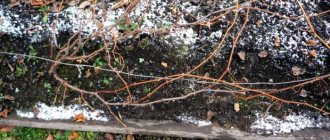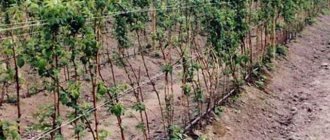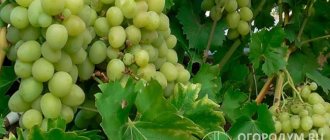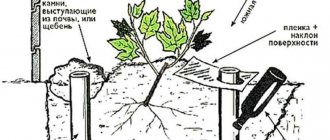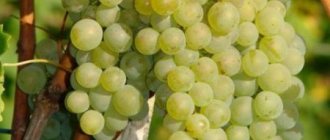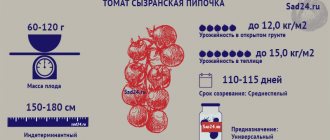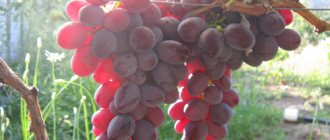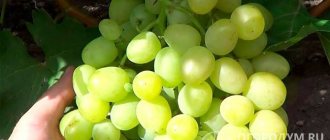The distribution area of grapes has expanded significantly over the past 10-20 years. This is due to the success of breeders. Gardeners were happy and surprised to learn that not only ornamental grapes can grow in mid-latitudes. There are cold-resistant sultana varieties of excellent taste and yield that can withstand temperatures down to −40°C.
Soil for grape seedlings at home
To plant cuttings and seedlings, you need to start preparing the soil in the fall. First, the soil is thoroughly dug up and fertilizing is applied. Chubuki are transplanted into special containers and transferred to a greenhouse or for growing from cuttings at home on a windowsill. You can use a mixture of humus and peat (1:1) or earth, peat and sand (1:2:1). For watering, use a solution of nitrate and superphosphate. When the cuttings grow to 30 cm, they can be transferred to open ground. Be sure to wait until spring when the air becomes warmer. Table varieties (Augustine, Harold) develop best in soil made of sand and crushed stone. This composition improves nutrition of the root system and accelerates the development of bushes, allowing the fruits to gain sweetness and aroma.
To ensure that the soil settles normally by spring, trenches or holes are dug.
For technical varieties, soil composition is very important. The taste properties of wines directly depend on the quality of the soil.
Soil for planting grape cuttings and seedlings
Planting grape cuttings has a peculiarity. This is the case when, for a seedling with roots of 5-10 cm, a planting hole with a total size of up to 100 × 100 × 100 cm is prepared and filled with the expectation of 2-3 years of growth.
- The so-called “planting” of the site is carried out: deep (up to 1 m) digging with improvement of the structural composition of the soil to meet the requirements of the grapes.
- To enrich the soil with nutrients, organic matter and mineral additives are added before digging at planting depths. For 10 m² of area they give: humus - 30-40 kg on chernozems (60-80 kg on sand), superphosphate - 0.5-1.0 kg.
- The soil must “settle” so that after planting the subsiding soil does not tear off the roots of the seedlings. The optimal period is 2-3 months. The area prepared for grapes in the fall will be saturated with winter moisture and averaged in elemental composition.
If it was not possible to prepare an area for planting grapes in the fall, all work is carried out in the spring, and the planting holes are filled with water (literally) so that the ground subsides.
Criteria for determining suitable soil
To get a luxurious vineyard, you need to choose the right soil composition. Grapes grow best in light soils that provide the roots with oxygen and water. The best options are loams, clay, chernozems, sand and sandy loam mixtures.
Good composition for seedlings
The best soil for growing grapes is a mixture of stones, clay, sand, minerals and organic matter. Heavy clay soils practically do not conduct air and water, so they are not suitable for planting a vineyard. Sandy ones quickly give up moisture and freeze in cold weather, which leads to the death of young plants. Also, the soil must contain iron, nitrogen, calcium, potassium, magnesium, phosphorus - a deficiency of these elements negatively affects plant growth. Read how to take grape cuttings in the fall here.
Acidity and alkalinity, which chibouk likes
The next important soil indicator is the pH level. It can be neutral, acidic or alkaline. For grapes, the optimal range is 4-8. Avoid soils with high acidity - in them the roots do not absorb nutrients well, and there is a need for additional soil fertilization.
Lime can be used to reduce soil acidity.
Composition of the earth
A very important point is the chemical composition of the soil for grapes, since the amount of fertilizer directly affects the full development and fruiting of the plant.
For this culture you need:
- Nitrogen. It is very important to maintain its measure. Its deficiency retards growth, and its excess negatively affects the ripening of berries.
- Iron. Helps stimulate the production of chlorophyll, which is important for high-quality plant nutrition.
- Potassium. It affects the taste of fruits: the more of it, the more sour they are. The immunity of the bush also depends on it
- Calcium. It has a positive effect on the root, but its excess can lead to chlorosis.
- Magnesium. Affects the production of chlorophyll. With its deficiency, the leaves turn prematurely yellow and fall off.
- Phosphorus. The abundance of fruiting directly depends on it. When it is oversaturated, the formation of bunches accelerates.
- Sulfur. This is the basis of proteins. Promotes the dissolution of mineral additives in the soil, helps the plant to fully nourish itself.
Improvement measures
All soil types can be improved if necessary. The nutritious dressing stimulates the processes of root formation in layering; to grow grapes from seed, it is recommended to use a mixture of humus and sand. It is recommended to fill the pots with the substrate and then place them in a well-lit, warm place. When propagating by cuttings, compost and garden soil are mixed in equal parts.
Measures to improve different types of soil are given in the table.
| The soil | Enhancer | Dosage |
| Clay | Coarse sand Bottom peat | 60 kg/m2 2 buckets per m2 |
| Medium loam | Coarse sand Bottom peat Compost | 25 kg/m2 2 buckets 0.5 buckets |
| Sandy loam | Chernozem Bottom peat Manure | 30 kg/m2 1 bucket per m2 4-6 kg/m2 |
| Sandy | Complete replacement with purchased soil | — |
What to look for when choosing soil
When deciding on a site for planting vines, they note what indicator plants grow there and how deep the groundwater is. The vine will reach the lower moisture-bearing horizons on its own, putting out long roots; in the case of a superficial location, the situation is worse. It may be necessary to drain the fluid, install a drain, or choose another location.
How to determine which soil is suitable for the acidity threshold
You can determine the optimal acidity of the soil using chalk, litmus paper, or by carefully looking at the plants growing on the site. Fireweed, horsetail, sorrel, millet, buttercup, violet, sardella, plantain, and sedum grow on acidic soil. Lime is loved by bindweed, larkspur, ulcer, mustard, bedstraw, quinoa, drowsiness, and poppy.
The most accurate way to determine soil acidity is litmus paper.
Litmus paper is easy to use - the indicator is dipped into a mixture of soil and water for a few seconds, and then the results are compared with the scale on the packaging. Do not use raw water for the test - distilled water is needed. Chalk is used according to the following scheme:
- A couple of tablespoons of soil are poured into the bottle.
- Add 5 tablespoons of water and a spoon of chalk.
- Close with a fingertip (the air is removed first).
- Wrap in paper and shake thoroughly.
Now look at the reaction - if the soil is acidic, then the fingertip will have to inflate.
How to choose a place
The choice of location for the future vineyard should be carried out according to the following criteria:
- the soil must be fertile. Forest soil or black soil is suitable;
- it must have the following mechanical qualities - sandy loam or light loamy soil;
- the thickness of the humus layer is at least 60 centimeters, maximum – 1 meter;
- the soil should not have a high density, it is not recommended to plant in sandy areas, it is forbidden to use saline or swampy soil for vineyards, as well as soil with high acidity.
For grapes, areas should be allocated that will be well illuminated by the sun, with a high concentration of moisture. The culture is very fond of water, which is necessary for the quality development of grapes.
Before planting, the selected area must be cleared of weeds.
Determination of humidity before seedling planting, preparation
Before planting grapes, be sure to determine the moisture content of the soil - its ability to retain water after watering depends on this indicator. The best way to do this is to use a tensiometer. The device indicates numbers and colors that are characteristic of a certain type of soil. To carry out horse measurements, the device is immersed in the soil.
The color readings of the tensiometer are easy to understand. Green is normal, blue and cyan are a lot of moisture, yellow, orange, red are water deficiency.
You can also determine soil moisture from plants. Drought-resistant crops are saxifrage, sedum, crassula, sedum, thyme, and sedum. Moisture-loving plants - water pepper, sedge, marigold, buttercup, meadowsweet.
Read about growing grapes in a greenhouse here.
Germination of shoots in water
The shoots are placed in a jar of water, at the bottom of which you must first place a two-centimeter layer of cotton wool. The layer of water should also be two centimeters. To prevent the water from becoming musty, you need to add activated carbon to it.
When the cuttings are in the jar, it should be placed on the windowsill. Water must be added periodically, but maintained at a level of two centimeters. A plastic bag is placed on top of the jar, creating conditions of high humidity. The roots of grape cuttings appear in the third or fourth week after being placed in water.
It is important to keep in mind that when germinating shoots in water, a special temperature regime must be observed: the lower part of the plant should be at a temperature of +27 degrees, and the upper part at a temperature of +15 degrees.
This regime promotes the appearance of roots before buds break.
To create the required temperature for the top and bottom of the shoot, it is placed above the radiator and the window is opened. But controlling the temperature is quite difficult. The second way is to place them on a warm floor.
An interesting method is to grow grape shoots in an aquarium in which they are aerated. To do this, the cuttings are placed on a foam bridge so that two-thirds of the plant remains in water. An aerator is placed in the aquarium. This germination system perfectly promotes the correct formation of the root system. The top of the shoots will remain cool, and the parts placed in warm water will warm up. The forced air will have a good effect on the developing roots, while the buds will not have time to bloom.
There is another way to germinate shoots.
To do this, the cuttings are wrapped in several layers of damp cloth and wrapped in polyethylene.
A small part of the escape remains outside.
A two-centimeter layer of sheet soil is poured into the selected container, and a glass without a bottom is placed on it. The space formed between the walls is covered with earth. Fine river sand is placed in the glass, then the inner vessel is removed. Make a hole five centimeters deep in a layer of sand and place a cutting in it. After watering, it is covered with dry sand and covered with a glass. The shoot should be placed in warm conditions, regularly watered with warm water.
Methods for increasing soil fertility, which one is best to choose
To increase soil fertility, mulching is usually carried out:
- Straw is an ideal fertilizer for sandy soils.
- Sapropel is a universal improver.
Sapropel should be used according to the instructions for its intended purpose - Category A is considered universal, B has an alkaline reaction, C is slightly acidic.
As part of basic preparation, purchased soil is mixed with the one already on the site in a one-to-one ratio. Mulch is made in a layer of 5 cm, which helps maintain soil fertility. You can prepare humus with earthworms or use three-tier structures in which fertilizers are removed as needed. Often the soil for vineyards is flavored with eggshells (it contains a lot of calcium).
Methods for protecting and restoring soil
Following numerous recommendations to keep the soil fallow between the rows leads to drying out of the soil and its weathering. To preserve soil moisture and restore soil fertility in a natural way, the use of green manure is effective, especially sowing legumes, which enrich the soil with nitrogen throughout the growing season.
To maintain conditions favorable for the functioning of soil microorganisms, it is recommended to cover the soil in tree trunk circles with a layer of mulch.
Such a protective layer of straw, dry or freshly cut grass:
- regulates soil moisture and heat exchange;
- protects against air erosion (weathering);
- suppresses the growth of weeds.
Labor-intensive maintenance of the soil in a state of “black fallow” (loose surface layer) brings nothing but harm to the vineyard.
Traditional fertilizers, selection and preparation
It is absolutely not necessary to buy expensive chemicals, and you can choose folk fertilizers. Basic:
- Manure – use 4 -6 kg/m2. Manure contains a full range of nutrients necessary for crops.
- Bird droppings are a product rich in nitrogen, but in a rather aggressive form. Before use, the substance is infused in water.
- Peat compost mixed with humus 3:1 - it is added in the spring at a rate of 3 - 4 kg/m2 after aging for 5-6 months. Please note that compost acidifies the soil (neutralization with chalk, dolomite flour, eggshells or ash is required).
- Yeast – initiates the processes of rotting, fermentation, and oxidation of plant residues.
Read about currants and manure at the link.
Horse and horse manure are used for clay and loamy soils, cow and pig manure for sandy and sandy loam soils.
Soil for grapes. Preparation, composition
Preparing the site for planting grapes
Soil and its importance for grapes.
The powerful development of the root system of a grape plant and its high adaptability to environmental conditions are the basis for the cultivation of grapes on a wide variety of soils.
It has been established that grape roots can penetrate to a depth of 8–10 m
, and in the horizontal direction up to 4–6
m
.
The best soils for vineyards in terms of mechanical composition are light sandy loam and loamy soils. Good results are also obtained when growing grapes on shallow and low-humus sandy soils underlain by loess and chernozem. Grapes can also be grown on rocky, gristly and clayey soils. Grapes grow very poorly on saline soils, and swampy soils are generally not suitable for planting them. The soil, its physical properties, and chemical composition have a great influence on the size and quality of the grape harvest, as well as on the timing of harvest and the nature of its use.
On sandy soils, the grapevine is characterized by strong growth and produces high and good quality yields. Table grape varieties accumulate a lot of sugar under these conditions; wine varieties growing on sand produce thin, light wines with a pleasant bouquet.
Grapes grown on rocky soils produce products of better quality and higher sugar content.
On cartilaginous soils, the yield of grape bushes is higher than on rocky ones, but sugar accumulates in the berries more slowly. On cartilaginous soils, it is best to grow varieties for the production of fine table wines.
Clay soils are best used for growing red grape varieties, which under these conditions produce highly colored, full-bodied wines. With the right choice of varieties on clay soils, you can get good yields of table grapes of quite satisfactory quality.
However, when choosing a site for a vineyard, it is necessary to take into account the fact that any soil can be improved through the use of fertilizers and appropriate cultivation.
Soil preparation.
The survival rate of grape plants, their yield and product quality depend on the degree of development of the root system. Powerful roots ensure good development of the aboveground part of the bushes. For the development of a strong root system, the soil must have the required amount of water, air, nutrients, and a certain temperature must be maintained.
Before starting to prepare the soil, the area allocated for planting grapes is cleared of stumps, bushes, trees, and large stones. Its surface is leveled, the holes are filled up, and the mounds are cut off.
If heavy clay soil that does not allow air and water to pass through well is allocated for the vineyard, then crushed stone, sand, turf soil or humus are added to it for improvement, mixing them well to the entire depth of cultivation. Immediately before planting, it is best to use humus for this purpose. To give cohesion to sandy soils, it is necessary to add manure and black soil to them.
In order to enrich the soil with nutrients, before digging, humus or manure is scattered over the surface of the site at the rate of 30 - 40 kg
for 10 sq.
meters of area when growing grapes on black soil and 60 - 80 kg
when growing them on sand.
Before spreading, add manure to 10 square meters of black soil. meters 0.6 - 1 kg
of superphosphate, and on acidic soils - 1 - 1.5
kg
of phosphate rock. During digging, manure is mixed with soil and buried to the planting depth.
Pre-planting soil treatment.
Grapes can only be planted on deeply loosened soil, since the root system of a grape plant develops mainly in the loosened layer of soil, and the presence of oxygen in the soil is one of the conditions for root growth.
Therefore, deep plowing or digging of the soil, the so-called planting, is necessary for the vineyard. Depending on the region where grapes are grown and the type of soil, planting is carried out at different depths: on loamy soils 65–70 cm
, on sandy soils 75–80 cm, on rocky soils 80–100
cm
.
You can plant grapes no earlier than 2 - 2.5 months after plowing the soil, since when planting in unsettled and uncompacted soil, air sacs form at the heels of the cuttings and the roots break off when planting grape seedlings. It is best to prepare the soil in the fall, without breaking up the blocks and leaving the surface of the area uneven, so that the soil retains precipitation well during the winter. In addition, the nutritional elements of manure applied in the fall have time to turn into a form accessible to the grape plant by spring.
If soil cultivation for grapes is carried out in the spring, then only humus and in no case straw manure should be applied, since the planted grape plants will suffer from a lack of nitrogen in the first year. To speed up soil compaction in the case of spring planting, the plowed area is filled with water.
In small areas, before digging, the site is divided lengthwise into two parts and crosswise into meter-long strips. Then, on the first half of the site in the first meter strip, a ditch 1 m
and 70–80
cm
, the soil from it is thrown to the edge of the site. Then the first groove is filled when digging the second meter strip, the second groove - when digging the third strip, etc. During digging, the top layer of soil is dumped to the bottom of the groove, and the bottom layer is poured on top.
If it is difficult to completely dig up the soil on the site, you can limit yourself to strip planting, which is also applicable in the case of wall grape cultivation. When belt digging, the width of the ditch should reach 70 - 80 cm
, and the depth is 70 - 100
cm
.
As a last resort, you can plant grapes in holes measuring 80x80 cm
and depth 60 - 70
cm
. When filling a hole, the top layer of soil is also poured onto the bottom, and the bottom layer on top.
Moving soil layers is advisable, of course, only in the case when the top layer of soil is more fertile than the bottom. However, there are cases, in particular on soils with humus at a depth of 40 - 50 cm
, when moving layers is undesirable. Here they limit themselves only to deep loosening of the soil. For better absorption of moisture, ditches and holes prepared in the fall should be left approximately 1/3 of their depth unfilled. Before planting, the soil surface on the site is carefully leveled.
Necessary disinfection when growing grapes
If there was a fungus on the plantings during the warm season, in the fall the vines are treated with preparations containing iron or copper. They spray both the bushes themselves and the soil underneath them (many pathogens normally tolerate even the most severe frosts in the ground). Superphosphates are applied in the first half of March, growth stimulants at the end of April, and then every two weeks. If you plan to use bird droppings, apply them simultaneously with growth stimulants. It is enough to use ammonium nitrate once - in the first half of May. In the fall, phosphorus, potassium and humus with ash are added.
You can make the right choice of a product for soil disinfection using reviews.
Category: “Questions and answers”
Question No. 1 . What external signs appear when grapes are over-fertilized?
The leaves change color and become pale. The shoots become thinner, the fruits lose their juiciness and taste.
Question number 2 . What to add to the soil against pests and diseases?
It is best to use EO preparations; they suppress pathogenic flora, strengthen plant tissues, and the grapes become invulnerable to pests.
Question number 3 . What is the difference between the soil for replanting grapes?
When transplanting, a drainage layer is laid at the bottom of the planting hole, on which garden soil with sand and humus is placed in a ratio of 2:1:1. Phosphorus-potassium fertilizers are added to the mixture. For survival, grape roots are treated with a stimulant, for example, “Kornevin”.
Features of improving soil quality for a vineyard in different periods
Plantings grow well and bear fruit if the soil contains a sufficient amount of nutrients and is free of weeds and parasites. Read about the spring treatment of grapes from diseases and pests in this material.
The range of care measures largely depends on the time of year:
- In the spring, the soil is dug up and leveled, nitrogen and/or ash are added. Remember that an excess of minerals is just as detrimental to crops as their deficiency. Treated against parasites.
- In summer, the soil is regularly loosened, watering schedules are drawn up, and weeds are removed.
- In the autumn, after the harvest is completed, the soil is dug up to 25 cm, the leaves and branches are removed. To retain moisture, do not break blocks of soil. You can apply potash fertilizers.
When preparing the holes, to avoid iron deficiency, nails or metal cans are placed on their bottom.
What you need to know about improving soil for mature bushes
The vine produces its first harvest 2 years after planting; a 3-4 year old bush is already considered an adult. During the first 2 years, the grapes use the nutrients from the planting hole. When the plant begins to bear fruit, this supply is depleted.
Vine growth and fruiting remove nitrogen, phosphorus and potassium from the soil.
To produce 1 kg of wine berries, the bush sucks from the soil (in terms of the net weight of the elements) 30 g of nitrogen along with potassium and 20 g of phosphorus.
These elements must be restored and added early in the spring:
- loams - once every 4 years;
- sandy soils - every 2-3 years.
To apply a dose of fertilizing closer to the roots themselves, even when planting the bush, install a piece of plastic pipe at the bottom of the hole. Liquid fertilizer is poured into the pipe. To reduce the concentration of the active substance, so as not to burn the roots, the grapes are watered through a pipe. The fertilizer goes directly into the root growth zone and is not wasted aimlessly on feeding weeds.
If pipes for feeding the roots are not installed, fertilizing can be applied to the cracks to a depth of 30-40 cm (the cracks are cut with a shovel).
If fertilizers are applied superficially, under digging around the tree trunk, the root system is damaged - the bush weakens and may die as a result of improper feeding.
If it is not possible to apply root fertilizing on time and correctly, during the first half of summer nitrogen and microelements are added to fungicides - treatment against fungal diseases is combined with foliar feeding of grape bushes.




